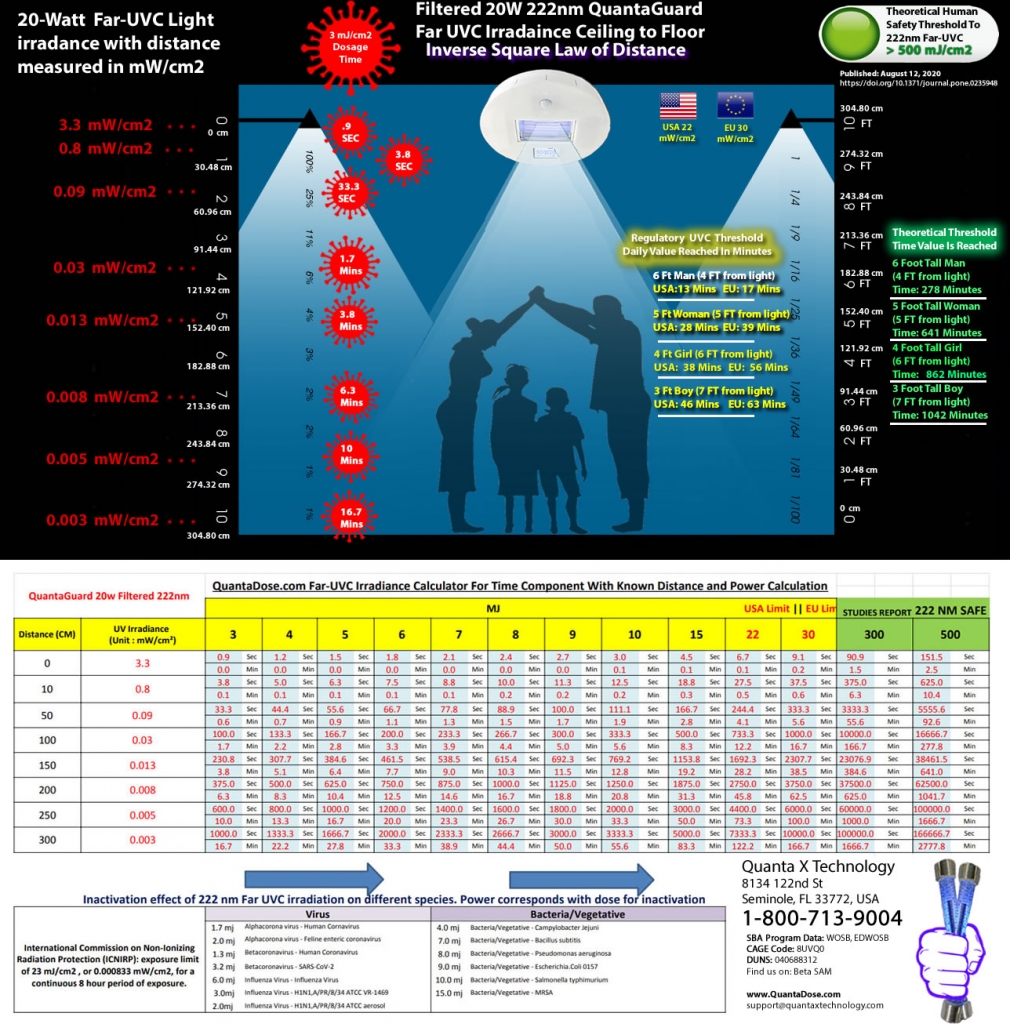In the press, QuantaDose Press Releases
How To Safely Install Far-UVC lighting for AP-UVGI Using Lights Inverse-Square Law of Distance To Understand Power, Distance and Time Dosage Requirements and Limitations
When mounting an overhead Far-UVC ceiling light with a ceiling height of 10 feet, there’s a 75% drop in light power from 1 Foot to 2 Feet, but only a 5% drop in light from 4 feet to 10 feet with only 1% of the Far-UVC light power available at floor level.
Power, Distance and Time Dosage RelationshipsFor those without an intense knowledge of advanced mathematics (or even elementary mathematics for that matter), something such as the inverse-square law can seem incredibly daunting.
There are equations with numbers and variables, references to physics, and many more things which, quite frankly, are technical in nature and very boring. For that reason, we’re going to cover this in an efficient way, rather than a technical one, and offer tools and charts that will make it even easier for everyone.
It can not be underscored enough how important it is to familiarize yourself with this basic mathematic principle to use the most cutting-edge bio-agent suppression method ever devised in human history – Far-UVC lighting.
The law itself, in AP-UVGI applications, using FAR-UVC light, applies to all lighting in general. It applies to any electromagnetic radiation, really. Its most relevant application here is germicidal irradiation using light wavelengths of between 207nm-230nm. This very narrow 23nm band of UV light was discovered as a small UV exposure window safe for humans yet deadly to pathogens responsible for the current pandemic!
FAR-UVC LIGHT IS OUR BEST WEAPON AGAINST FLU!In a nutshell, it teaches how to use UV light as a weapon in the War on Flu! The inverse-square law teaches us how light works over distance and why the distance between your Far-UVC light source and your target area is so important when the amounts of light reaching areas are paramount to the safety of people and the effectiveness of UVGI (Ultraviolet germicidal irradiation), or if adding Active Personal into the UV zone than, AP-UVGI, however just think of it as invisible light to keep things simple.
Let’s say we have a light source that is on full power and our bio-agent target is 1 foot away from it. If the target moves double the distance away from the light (2 feet), how much of the light’s power will reach it?
The natural reaction is to think “half power” – but unfortunately that’s now how light works, all light, including germicidal Far-UVC light follow a mathematical rule known as the inverse-square law of distance.
FAR-UVC LIGHT IS OUR BEST WEAPON AGAINST FLU!According to the law, the power of the light will be inversely proportional to the square of the distance. So if we take a distance of 2 and square it, we get 4, the inverse of which would be 1/4 or rather, a quarter of the original light power – not half.
Moving our target 3 feet from the light source (3 * 3 = 9, so 1/9) the power of our light on the target now becomes 1/9th of what it originally was, and this is where time becomes a very important factor for effective germicidal irradiation and for the safety of active personnel in the UV light disinfection zone over extended periods of time.
The below chart (click to enlarge it) shows how the power of light drops from one 20w Far-UVC light mounted at a ceiling height of 300cm to the floor using a 20-watt 222nm excimer KrCl lamp properly bandpass filtered for a human-safe AP-UVGI application.
https://www.quantadose.com/wp-content/uploads/2021/03/light-chart-with-infographic.jpgThe inverse square law explains the dramatic drop-off in Far-UV light over distance. We can use this information to better understand how Far UVC lights are affecting either people in a room or how to control bio-threats in the room with them by using this measure.
Putting Far-UVC light to Work
So knowing about light fall-off is fun and everything… but how can we put it to good use in our disinfection process around Active Personnel (AP-UVGI)? Well, it’s all about exposure and relative to light power and positioning. When a Far-UVC light shines in a particular direction, initially the drop-off in far-UVC power is very quick, then it slows down the further it goes as it becomes weaker in relationship to the percentage of the original power output.
Remember that with a square law, the numbers get bigger more and more quickly, however with an inverse square law the numbers get smaller more and more slowly.
If we look at our light drop-off from 1 meter to 10 meters in percentages to the nearest whole number, it would look like this:
Conclusion
This has only been a very brief introduction to the inverse-square law as it applies to Far-UVC light sources in UVGI, UR-UVGI and AP-UVGI. There are many, many variables that are equally important for the safety of active personnel exposed to the Far-UV light and the effectiveness of the UV disinfection process and accumulated UV dosage.
Hopefully however, you now understand the basics of the inverse-square law and you can start applying it to achieve a healthier living and working environment with Far-UVC.
If you have any hot tips to help people out with understanding this subject, or anything else you’d like to share about Far-UVC lighting, then please do email us at support@quantaxtechnology.com or join FarUV.lighting for community support from Far UVC business professionals from around the world.


